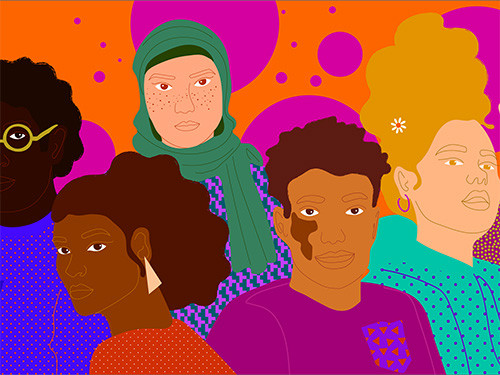 (Illustration by Aurélia Durand)
(Illustration by Aurélia Durand)
In an equitable world, a child’s background would not determine their life outcomes. However, in reality children whose families or communities face systemic disadvantages in everything from healthcare to education to employment are far less likely than children of privilege to secure the life opportunities they desire for themselves.
Teach For All strives to develop the collective leadership needed to ensure that all children have the opportunity to fulfill their potential, by focusing on the root causes of unequal outcomes for children. It is comprised of a network of independent, locally-led partner organizations in 50 countries, as well as a global organization that supports the network’s progress and impact. Teach For All also has undertaken significant efforts to ignite conversations around diversity, equity, and inclusion (DEI), which affect every aspect of how the global network and organization operate—from attracting and retaining diverse staff to creating visions for student success hand-in-hand with families and communities.

There is no path to systemic change without examining the root causes of injustice, especially in places where indigenous or marginalized populations have suffered from racially motivated and/or colonial oppression, or where refugee or immigrant communities experience systemic discrimination. This work is often uncomfortable, particularly for those who have benefited from the status quo. Yet, being uncomfortable is essential for sparking change.
The four most important lessons Teach For All has learned through this process are common at a global level, even though they rooted locally, with each community’s racial demographics and history being specific to its context.
1. Define Equity
Teach For All defines equity as removing the predictability of failure or success based on social background or factors. However, each partner in the network has grappled with what equity looks like within its local context. Despite differences in contexts, what each partner has in common is that most societies have not been designed to ensure equity, since historically members of the group that holds the most political and cultural power have disproportionate privilege and access to opportunity.
In addition, Teach For All partners have realized that equity and equality do not mean the same thing. Equality means the equal distribution of assets, independent of one’s starting point or level of privilege, whereas equity accounts for disparities caused by historical privilege and discrimination. Therefore, Teach For All’s global organization ensures that its operations and programming are directed towards equity. It supports its network organizations to develop their own working definition and framework for action aimed at the goal of equity through fellowships, conferences, virtual learning experiences, and coaching opportunities that help them interrogate the roots of inequity in their countries, including racism, xenophobia, and colonialism.
2. Value Lived Experience More Than Concepts
For many, the term “white supremacy” immediately conjures images of white hoods or neo-Nazi rallies. People of European descent often distance themselves from the term when it is applied to what they believe to be extremist or far-right views and behaviors.
However, Teach For All considers in its DEI work a definition of white supremacy as a system that places European beliefs, aesthetics, ways of working, social organization, and contributions above all others. It is the hallmark of any society where it is advantageous to look, speak, organize, or work in ways that are Eurocentric. White supremacy pervades global social standards, from how Western education is viewed as superior to local education in some countries in the global South, to colorism, or the preference for lighter skin.
Given white supremacy’s deep entrenchment and its role in creating the systemic barriers that children face today when it comes to their education and healthcare, DEI work requires its discussion. However, leading with this term in diverse contexts can be counterproductive if it prompts defensiveness. In such cases, insisting to use the term can present an excuse for people to disregard the larger point because they are distracted by its use and refuse to move past it, or state categorically that the term is an egregious application to the local form of racial discrimination they want to address.
A more effective approach is to lead with an inquiry about the problems faced by marginalized groups within a specific context. For example, indigenous groups throughout the Americas encounter far more obstacles in securing access to economic opportunity, but some in the region do not think of this as a racial issue. However, when asked why indigenous groups have been pushed to the margins, those who were reluctant to acknowledge the role of race eventually arrive at colonialism’s legacy—which is rooted in the belief in the supremacy of European ways, values, and the right to dominate others.
3. Center Local Voices
Communities that have experienced racial and ethnic marginalization have been having conversations about equity long before it became a trend in the social sector. However, these communities are rarely given center stage when outside organizations come in to facilitate equity work. These organizations, however, can gain incredible skills and insights from partnering with communities and learning from their firsthand experience with inequity in the greater goal of changing systems.
Teach For All’s network partners engage in extensive relationship building, beginning with learning from families and community members about their histories, beliefs, assets, and aspirations for their children. Partners commonly spend months or even years listening to and becoming part of local communities in order to jointly create a culturally sustaining and validating vision for students before launching a Teach For All partner organization.
Some partners have reformed their organizations based on community feedback. For example, Teach For All’s process of selecting the individuals to train to become classroom leaders is one of the most crucial parts of the network’s unifying approach. In New Zealand, Ako Mātātupu: Teach First NZ redesigned their process of selecting participants into their program after working with Māori to understand their concept of leadership. Using the community’s descriptions, the organization amended their selection process to reflect indigenous values. They now have a nearly 50/50 cohort of European-descended and Māori and Pasifika teachers.
Making progress toward equity requires collective, inclusive, and locally driven leadership. Through collaboration with local leaders, groups can work together in a way that facilitates meaningful change for everyone.
4. Diversity is Insufficient Without Inclusion
While it is important to have diverse voices at all levels of an organization, diversity is insufficient if marginalized people feel less valued or included, or do not have meaningful roles in decision-making and leadership. Inclusion represents a commitment to the goal of shared power—equity—through ensuring that organizations are welcoming and safe for all people, especially those who are not part of the dominant culture. Remember, the opposite of inclusion is marginalization.
In locations where DEI efforts are dismissed because of a false belief that the local or national demographics are racially or ethnically homogenous, even in countries composed overwhelmingly of one major ethnic group there are invariably minority groups. As such, Teach For All works with network partners to look closely at their long-held beliefs about inclusion and marginalization. This involves encouraging leaders and staff to educate themselves about the national and local histories of inequity and marginalization, which often results in the confronting of their own privilege.
Equity Work Takes Time and Commitment
The work of truly understanding racial inequity can be uncomfortable, and it takes a great deal of time and investment. However, organizations that claim to pursue racial equity and racial justice but fail to root their work in a thorough understanding of the causes of racial inequity are unlikely to achieve their ultimate goal. They are also unlikely to establish the unity that becomes possible through the hard work of confronting privilege and re-grounding the organization in the lived experiences of marginalized communities.
Support SSIR’s coverage of cross-sector solutions to global challenges.
Help us further the reach of innovative ideas. Donate today.
Read more stories by Anasstassia Baichorova & Samantha Williams.

